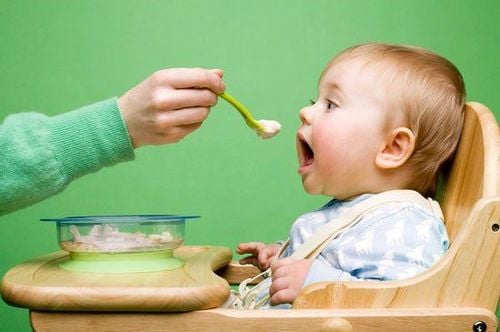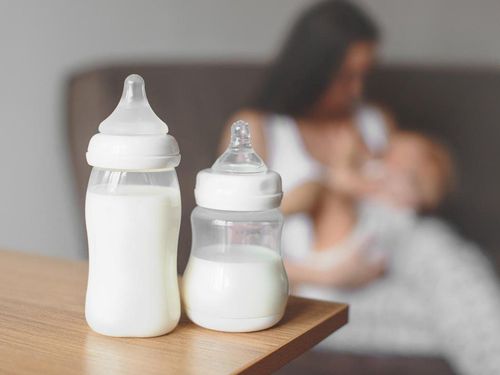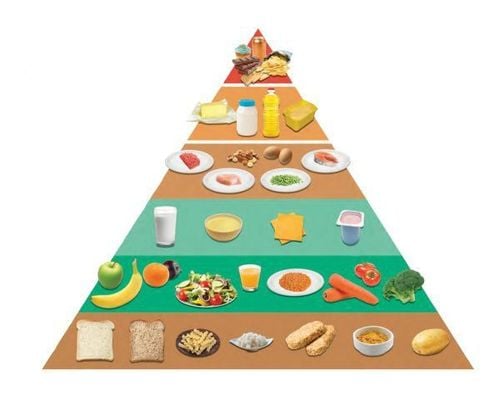This is an automatically translated article.
Children's bodies always need to be provided with adequate nutrients every day to be able to grow healthy, smart and strong. At the age of 6-12 months, babies are growing rapidly, so their bodies need more energy and nutrients than at any other time in life.
1. Baby's first weaning food
Although the baby is 6 months old and can gradually get used to solid foods, breast milk is still an indispensable source of nutrition for the baby. In addition to breast milk, solid foods help meet your baby's growing energy and nutritional needs.
After the baby is breastfed or in between feeds, you can give your baby some of the first solid foods to encourage the baby to continue breastfeeding as much as possible. When starting to feed your baby solids, you need to pay attention to clean your baby's hands and feet, because bacteria can enter from the hands into the mouth when the baby picks up food. In addition, during food preparation, you also need to make sure to wash your hands thoroughly to avoid infecting your baby.
Six months old is the time when babies start to chew, so the first solid foods for babies need to be soft and easy to swallow. Examples include porridge, fruit or vegetables that have been thoroughly mashed. When cooking porridge for babies, you need to cook it thickly, avoid adding too much water, because it may not provide enough nutrients for children.
Besides, you should feed the child if you notice that the child is showing signs of hunger. For example, the act of putting your finger to your mouth, also known as sucking. After washing your hands, start by feeding your baby just 2-3 tablespoons of soft food about twice a day. The reason why you should not feed your baby too much is because the baby's stomach is still small to be able to digest food in time.
For the first time, babies may feel surprised and delighted with the new flavors of foods other than breast milk. Mothers should give their children a certain amount of time so that the baby can adapt and get used to these new foods and flavors. In addition, you should also be patient and do not force your baby to eat, and watch for signs that the baby is full.

Thức ăn dặm cho trẻ cần loãng và mềm
2. How should we feed babies from 6 to 8 months old?
You should give your baby from 6 to 8 months old about half a cup of soft food 2-3 times a day. Babies can eat any food, except honey, because it can cause poisoning for children under 1 year old. From 12 months and up, you can start offering your baby healthy snacks with mashed fruit. Even though your baby has learned to eat solid foods, it is still a good idea to continue giving your baby breast milk to make sure he gets all the nutrients he needs.

Trẻ từ 6 – 8 tháng tuổi tuyệt đối không nên cho ăn mật ong
3. How should we feed children from 9 to 11 months old?
9-11 month olds can eat half a cup of food 3-4 times a day, plus a healthy snack. At this stage, soft foods can be cut into small pieces, instead of finely ground them. Your baby may even begin to scoop food with his or her own hands. However, mothers should still pay attention to feeding their babies whenever they feel hungry.
Each meal needs to ensure that the baby has an interest in eating, the food needs to be rich in energy as well as nutrients. Besides potatoes and cereals, you should give your baby more vegetables and fruits, nuts and beans, along with small amounts of energy-rich oils or fats. Especially animal foods, such as eggs, milk, fish, meat and poultry. Adding these foods to your daily routine will give your baby the best chance of getting all the nutrients he or she needs to grow.
In case the child refuses to eat the new food or spits the food out, it is best not to try to force the child to continue eating but should try again about a few days later. Or you can also try mixing your baby's food with another food your baby loves, such as expressing breast milk on top of the food.

Ở giai đoạn từ 9 – 11 tháng tuổi trẻ có thể ăn được trái cây
4. How to feed your baby other than breast milk
If the baby is not breastfed, the baby needs to be fed more often. Your baby will need a variety of other foods, including dairy products, to get all the nutrients his body needs.
For non-breastfed babies, you should also start introducing solid foods around 6 months of age, similar to the needs of breastfed babies. Children should be given 2-3 spoonfuls of soft foods for the first time and about 4 times a day. This will help provide the baby with important nutrients without the need for breast milk.
Between 6 - 8 months old, your baby will eat about half a cup of soft foods about 4 times a day and add another healthy snack. By the time your baby is 9-11 months old, your baby's feeding frequency will increase to four to five times a day, plus two other healthy snacks.
A perfect diet and good parenting will help children develop comprehensively as well as limit the risk of diseases. Therefore, depending on the stage, parents need to give their children different diets to best suit their baby's age.
For children to be healthy and develop well, it is necessary to have a nutritious diet in terms of quantity and quality balance. If children are not provided with adequate and balanced nutrients, it will lead to diseases of excess or lack of nutrients, which adversely affect the comprehensive development of children in terms of physical, mental and motor skills.
The period of baby eating solid foods is an extremely important period to help children develop comprehensively. Children who do not eat properly are at risk of micro-mineral deficiencies, causing anorexia, growth retardation, malabsorption, etc. If they notice the above signs, parents should supplement their children with supportive products. The supplement contains lysine, essential micro-minerals and vitamins such as zinc, chromium, selenium, and B vitamins to help fully meet the nutritional needs of children. At the same time, these essential vitamins also support digestion, enhance nutrient absorption, help improve anorexia, and help children eat well.
Parents can learn more:
Signs of zinc deficiency in children
Micronutrient deficiency and failure to gain weight in children
Please regularly visit Vinmec.com website and update useful information to take care of your child. Take care of the baby and the whole family.
Reference source: unicef.org - parents.com













